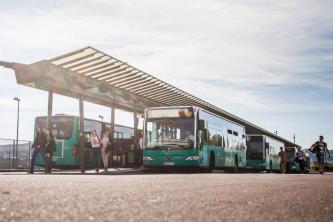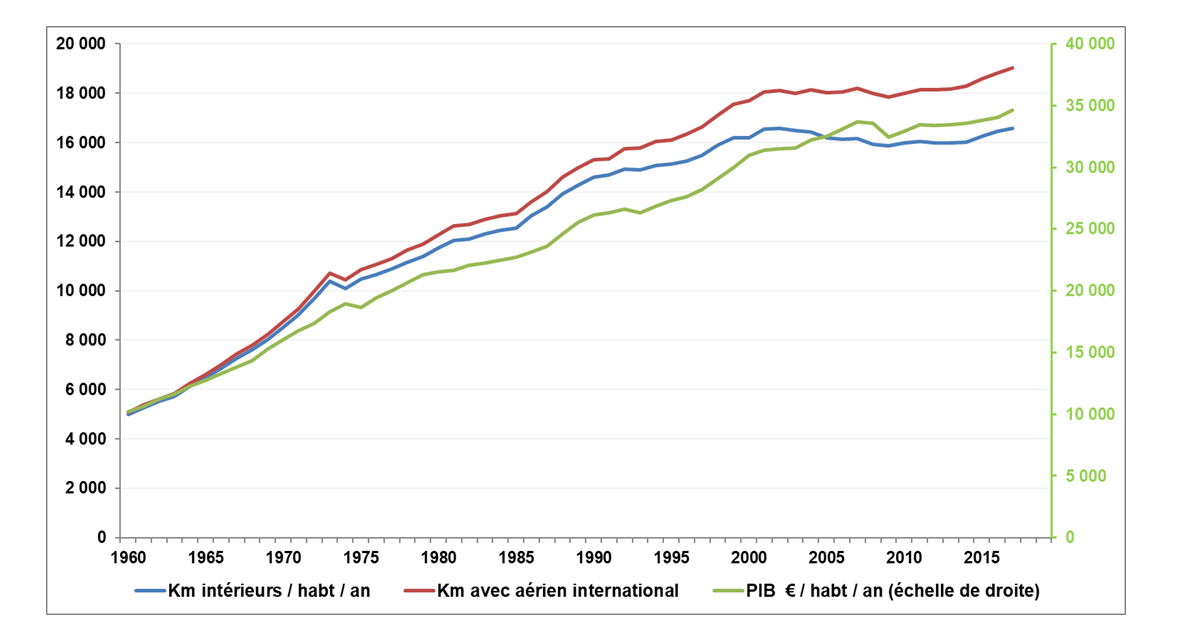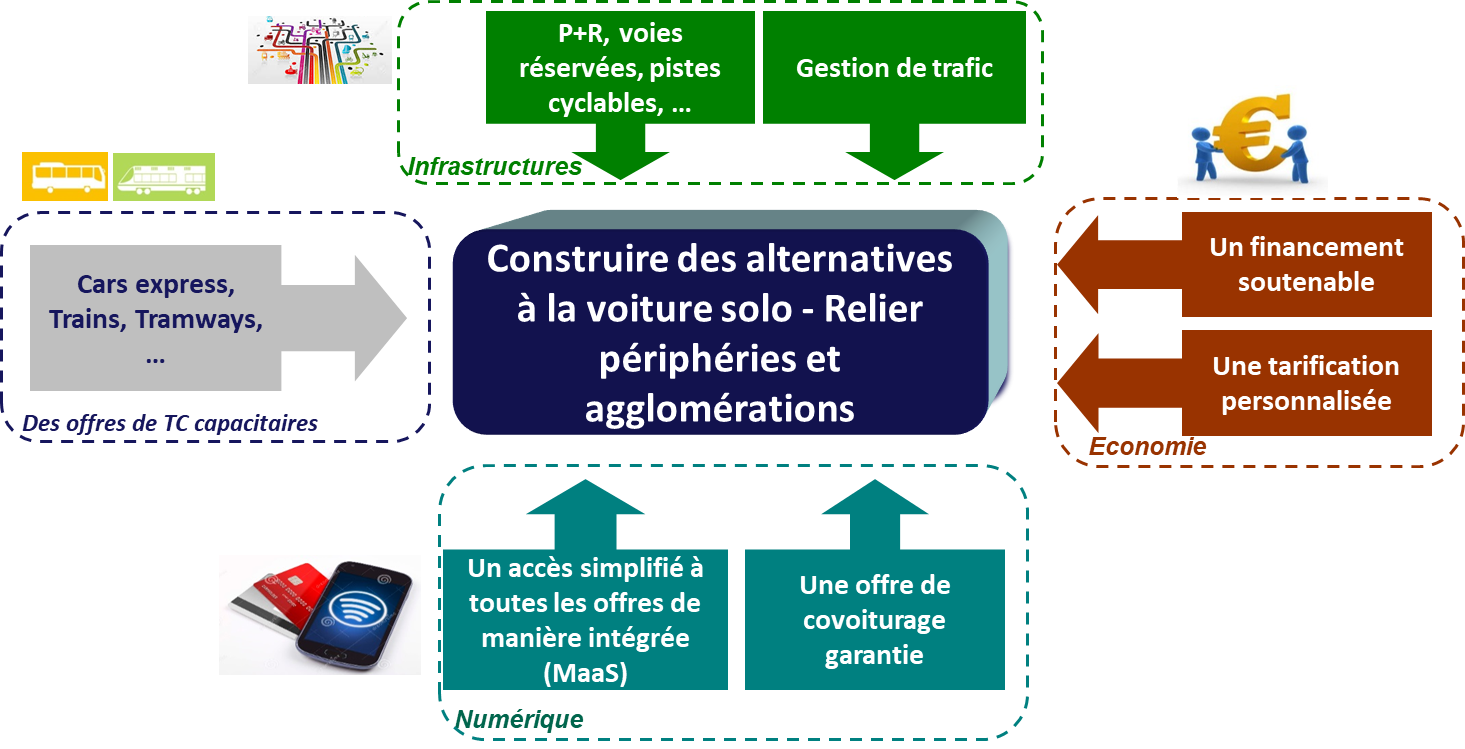
19 octobre 2020
Reducing our CO2 emissions by 60% within 10 years, as the European Parliament aims to do, requires an unprecedented modal shift. Jean Coldefy discusses the implications of such a goal, which requires boosting public transport supply and limiting car use. Funding such a program implies a revolution in mobility pricing. Do politicians realize this and how will they get citizens on board?
In order to limit global warming to 1.5 degrees Celsius within 10 years, we need to reduce our CO2 emissions by 60%, which is the new target recently set by the European Parliament. Transport is the main source of emissions in France. Cars account for half and of these emissionswith trips performed to access urban areas making up the largest share. Over the past 20 years, metropolitan economic dynamics, the decline of industry in other territories and the threefold increase in real estate prices in large cities have created a disjuncture between jobs and housing. The supply of TER’s (local regional trains) has unfortunately not kept up with this territorial dynamic, and with scattered urban planning, this has greatly favored the use of cars to access urban jobs. This traffic accounts for half of urban mobility emissions, and while trips within urban centers represent only 2% of the total, the rest is made up of trips within the inner suburbs and periurban areas.

Source J. Coldefy based on data from CEREMA DEEM / ENTD
There are three possible ways to reduce these emissions: reduce vehicle emissions, reduce distances travelled, switch from individual cars to shared transport (i.e. modal shift).

Source J. Coldefy
This is the point of electric cars. In France, they have the potential to reduce car-related CO2 emissions by 75%, given that the energy supply is largely low-carbon. The difficulty lies, on the one hand, in how quickly it can be deployed, and on the other, in its cost, which probably won’t be the same as an internal-combustion engine car until 2025. Yet, an internal-combustion engine car bought in 2020 will still be around in 2035, and it is estimated under these conditions that by 2030, in the best case scenario, electric cars will contribute to the reduction of mobility-related CO2 emissions by only 20%.
The goal here is to organize space in order to reduce car use and the space occupied by cars. This means having a land planning strategy that is based on a proximity ensured not by speed, but by distance. A planning strategy promoting walking and cycling for local travel and public transport for long trips (mainly commutes) is essential, but the problem is that it will take 30 years for this to have an impact.
Reducing distances traveled also means organizing activities differently, for example through the development of telework. However, studies show that teleworkers do not necessarily move the least. 1 We will need to analyze in the long term what lasting impact Covid-19 has on the frequency and distance of our movements.
History shows that the distances covered in France have been stable for 20 years: 45 km/day/person. If electric cars can only reduce emissions by 20% within 10 years and if distances travelled don’t significantly decrease, we will need to ensure that there is a 50% modal shift from cars to shared transportation. This is considerable, especially given that the car’s share in overall kilometers travelled has remained stable for 30 years at 80%, despite 75 billion euros being invested in urban public transport and the TGV high-speed train (source CTN / SDES).

Evolution of passenger x km / inhabitant 1960 - 2017 (Aurelien Bigo 2) and GDP / hab (J Coldefy)
A modal shift will therefore be the heart of the energy transition. During the next decade, we must focus our efforts on the links between peripheries and employment zones in cities, and not just city centers.
Will promoting cycling be enough? Cycling ticks all the boxes for good urban mobility: it is faster than cars during peak hours, a bicycle occupies up 3 times less space and doesn’t emit GHGs. And it doesn’t cost too much public money. Despite these undeniable advantages, cycling has one main flaw: range. The flow of incoming cars into urban areas accounts for 50% of urban emissions, and these trips can hardly be made by bicycle. In Strasbourg, Copenhagen and Amsterdam, model cities for cycling, the share of cycling is up to 10 times higher than in Lyon. On the other hand, in these cities the share of cars is higher than in Lyon where the share of public transport is higher. Cities where cycling is well developed are also those in which you walk the least. In cities, the effectiveness of cycling on a modal shift isn’t as clear-cut or as significant as its supporters would like to claim.
It is therefore mainly in the areas beyond the ring-roads of large cities that bicycle paths should be developed for trips of up to 5-10 km (with electric bikes), for which walking is more difficult due to the greater distances. Reducing car use will require a combination of bicycles + public transport, by massively deploying park-and-ride facilities to access buses, trams and subways.

To address the challenge of linking peripheries and cities, there needs to be a mobility package that includes:
With this device, citizens will be able to save time and money - up to 10 hours and 200 euros per month - for those who commute 100 km every day.

Source J. Coldefy
History shows that without constraints car use doesn’t decrease. Electing environmentalists, who make it a priority to fight global warming, will make the implementation of these constraints more likely. Current constraints are sometimes poorly targeted (in city centers) and implemented before the alternatives, which is likely to undermine social and territorial cohesion and reignite a Yellow Jackets crisis. Therefore, these constraints should target three areas:
Achieving such a program within 10 years - not 30 - requires additional resources. Given the current taxation levels of individuals and businesses, road pricing seems necessary for accessing large cities, especially considering that the electrification of vehicles will lead to a tax loss for the TICPE (Internal Consumption Tax on Energy Products). This pricing must be implemented once the alternatives are in place, exempting or compensating low-income households, and with a 100% allocation of revenues to a specific mobility program. It should be low (1 to 2 euros/day) and only on working days, excluding school holidays.
In addition, the deployment of ITS tools (Intelligent Transport Systems) such as MaaS will enable the pricing of mobility based on use, with the aim of recovering a revenue expenditure (commercial revenue/operating expenses) of 50% in public transport (as is the case in Lyon and other European countries), thus twice the current ratio of 25%, in order to have investment capacities. There are many options and they need to be assessed according to geographical areas: switching to a pricing based on family income and introducing a pricing based on distance, maintaining a subscription for home/work commutes and remote payments for other trips, modulating according to rush hours (which generate high additional costs in public transport), pricing according to a given mode’s quality of service, including speed, etc. MaaS tools allow for great flexibility and offer opportunities that need to be seized.
Achieving this program requires governance at the level of urban areas and thus coordination between regions and cities and even with the state and departmental councils for roads. In this regard, transferring all national roads to regions and their cities would greatly facilitate the fast implementation of the program. The same can be said for the strategic departmental roads needed to build dedicated lanes. This new governance will have to decide on the mobility program, its funding and the allocation of resources. This is what the northern European territories have been doing for 30 years.
Politicians are probably unaware of the implications of reducing CO2 emissions by 60% within 10 years: never in the last 20 years have we been able to reduce daily distances travelled, nor the modal share of cars. If we take these political objectives seriously, and if we are serious about the climate crisis, we need unprecedented reductions - by about 50% - of car use to access major cities, and in order to achieve this we need to boost public transport and put constraints on cars. Will politicians go beyond their wishful thinking to implement such a program and convince the citizens to get on board?
1 See the National Mobility and Lifestyle Survey https://en.forumviesmobiles.org/project/2019/01/07/national-survey-mobility-and-lifestyles-12797
2 See also Aurélien Bigo's article, “France’s National Low-Carbon Strategy: can it work without slowing down?" https://en.forumviesmobiles.org/mobilithese/2020/06/18/frances-national-low-carbon-strategy-can-it-work-without-slowing-down-13348
3 See the work of the Digital Mobility Observatory.
For the Mobile Lives Forum, mobility is understood as the process of how individuals travel across distances in order to deploy through time and space the activities that make up their lifestyles. These travel practices are embedded in socio-technical systems, produced by transport and communication industries and techniques, and by normative discourses on these practices, with considerable social, environmental and spatial impacts.
En savoir plus xA lifestyle is a composition of daily activities and experiences that give sense and meaning to the life of a person or a group in time and space.
En savoir plus xLifestyles
Other publications